
Episode 132: Solemnity of the Ascension of the Lord, Year C
In today’s episode, we focus on details relevant for apologetics found in the readings for this upcoming Solemnity of the Ascension of the Lord, Year C. We’ve already had the opportunity to reflect on details specific to the ascension in episode 26 of the Sunday Catholic Word, which dealt with the readings for the Ascension in Year A. The details that we’ll focus on in today’s episode deal with our Lord’s resurrection, which is highlighted in the first reading, taken from Acts 1:1-11, and Jesus’ high priestly ministry in the heavenly sanctuary, taken from the optional second reading, which is Hebrews 9:24-28; 10:19-23. The apologetical detail that’s worthy of note in the Gospel deals with the Sacrament of Reconciliation and will only be briefly noted due to our treatment of it for Divine Mercy Sunday.
Hey everyone,
Welcome to The Sunday Catholic Word, a podcast where we reflect on the upcoming Sunday Mass readings and pick out the details that are relevant for explaining and defending our Catholic faith.
I’m Dr. Karlo Broussard, staff apologist and speaker for Catholic Answers, and the host for this podcast.
In today’s episode, we’re going to focus on details relevant for apologetics found in the readings for this upcoming Solemnity of the Ascension of the Lord, Year C. We’ve already had the opportunity to reflect on details specific to the ascension in episode 26 of the Sunday Catholic Word, which dealt with the readings for the Ascension in Year A. The details that we’ll focus on in today’s episode deal with our Lord’s resurrection, which is highlighted in the first reading, taken from Acts 1:1-11, and Jesus’ high priestly ministry in the heavenly sanctuary, taken from the optional second reading, which is Hebrews 9:24-28; 10:19-23. The apologetical detail that’s worthy of note in the Gospel deals with the Sacrament of Reconciliation and will only be briefly noted due to our treatment of it for Divine Mercy Sunday.
Let’s get started with the first reading, Acts 1:1-11. The relevant detail is only in the first half of the passage, verses 1-5. So, I’ll read that section and then give some commentary. Luke records,
In the first book, Theophilus,
I dealt with all that Jesus did and taught
until the day he was taken up,
after giving instructions through the Holy Spirit
to the apostles whom he had chosen.
He presented himself alive to them
by many proofs after he had suffered,
appearing to them during forty days
and speaking about the kingdom of God.
While meeting with them,
he enjoined them not to depart from Jerusalem,
but to wait for “the promise of the Father
about which you have heard me speak;
for John baptized with water,
but in a few days you will be baptized with the Holy Spirit.”
The first detail that I wanted to highlight is Luke’s comment that Jesus “presented himself alive to the [disciples] by many proofs after he had suffered.” The apologetical significance here is that this detail counts against many alternative theories to the Christian claim that Jesus rose from the dead.
For example, for Luke to say that Jesus proved he was alive tells us that the early Christians were able to exclude the common proposed alternative explanations for their belief that they saw Jesus after death. That he proved to them he was alive excluded the possibility that he would have been a ghost. In fact, Luke tells us that’s exactly what the apostles thought they saw when Jesus appeared to them (Luke 24:36-43). But, of course, Luke records that Jesus dispelled that notion for them, inviting them to touch him.
That Jesus proved himself to be alive also allowed the Christians to exclude the possibility that they were hallucinating, or that Jesus was a vision. The proofs that Jesus gave them to convince them he was alive don’t fit with the hallucination and vision theory. Again, for example, Jesus invited them to touch him. And we safely assume they did. He even ate with them, handing them food to each on the seashore in John 21. Hallucinations and visions don’t share meals with people.
Finally, that Jesus proved himself to be alive also refutes the idea that Jesus rose within their hearts, a view known as the “spiritual resurrection” theory. The early Christians were convinced via the proofs that Jesus was alive. Surely, the early Christians would have known the difference between Jesus being alive in the flesh and having a spiritual experience of Jesus in their hearts.
Another detail in this section of the first reading that relates to these issues is the fact that Jesus appeared to the apostles and hung out with them for forty days. That in itself is proof that he was alive.
But, more specifically, it refutes the hallucination theory. How could so many of them simultaneously have the exact same different hallucinations on each of the days that they said Jesus was with them? Hallucinations are subjective in nature and thus will be different for individual people. The forty-day encounter, therefore, simply cannot be accounted for by the hallucination theory.
Okay, let’s now turn to the optional second reading, taken from Hebrews 9:24-28; 10:19-23. I will only focus on verses 24-28:
24 For Christ has entered, not into a sanctuary made with hands, a copy of the true one, but into heaven itself, now to appear in the presence of God on our behalf. 25 Nor was it to offer himself repeatedly, as the high priest enters the Holy Place yearly with blood not his own; 26 for then he would have had to suffer repeatedly since the foundation of the world. But as it is, he has appeared once for all at the end of the age to put away sin by the sacrifice of himself. 27 And just as it is appointed for men to die once, and after that comes judgment, 28 so Christ, having been offered once to bear the sins of many, will appear a second time, not to deal with sin but to save those who are eagerly waiting for him
Notice the author tells us Jesus has entered the heavenly sanctuary “in the presence of God on our behalf.” And he has done so not to offer himself repeatedly, as the high priest entered the Holy of Holies yearly with the blood of an animal. Rather, “he has appeared once for all at the end of the age to put away sin by the sacrifice of himself.”
The appearance of Jesus that the author speaks of there in verse 26 is not a reference to appearing on Calvary. Rather, it’s Jesus’ “appearance” in the heavenly sanctuary that the author spoke of verse 24: “Christ entered the heavenly sanctuary to appear on our behalf.”
This means Jesus is forever making present his single sacrifice in the heavenly sanctuary in an unbloody manner and offering it to God the Father. This is his high priestly ministry by which he forever intercedes for us.
And it’s on account of this making present of his sacrifice to the Father in an unbloody manner that we are saved here and now. Jesus’ sacrifice, therefore, is not restricted to an event in the past. It takes an eternal dimension and is forever present to the Father.
What’s the apologetical significance?
The Catholic Church teaches that the Mass is the single sacrifice of Christ made present in an unbloody manner, which is no different in principle than the theology that the author of Hebrews reveals to us in our reading. Therefore, if anyone rejects the theology of the Mass as the single sacrifice of Christ made present in an unbloody manner because they think it somehow undermines the sufficiency of Jesus’ death on the cross, then he will have to reject the author of Hebrews teaching. But that’s not something any Christian should want to do.
Now, to relate this revelation to the solemnity of the Ascension, it reveals that entrance into the heavenly sanctuary to forever present his single sacrifice to the Father is the very the purpose of the Ascension. The mystery of the Ascension and the sacrifice of the Mass, therefore, are intrinsically connected to each other.
So, this optional reading from Hebrews 9 gives us the biblical roots of the theology of the Catholic Mass.
Conclusion
Well, my friends, that’s all I have for this episode of the Sunday Catholic Word. The readings for this upcoming Solemnity of the Ascension of the Lord, Year C, provides us with a few details that are relevant for apologetics:
- We have material to refute several theories that attempt to explain away the postmortem appearances of Jesus,
- And we have material that biblically justifies the Catholic understanding of the Mass as the Sacrifice of Christ.
As always, I want to thank you for subscribing to the podcast. And please be sure to tell your friends about it and invite them to subscribe as well through any podcast platform that they use. You can also access the archived episodes of the Sunday Catholic Word at sundaycatholicword.com.
You might also want to check out the other great podcasts in our Catholic Answers podcast network: Trent Horn’s The Counsel of Trent, Joe Heschmeyer’s Shameless Popery, and Jimmy Akin’s The Jimmy Akin podcast,” all of which can be found at catholic.com. And if you want to follow more of my own work, check out my website at karlobroussard.com
One last thing: if you’re interested in getting some cool mugs and stickers with my logo, “Mr. Sunday podcast,” go to shop.catholic.com.
I hope you have a blessed Ascension Sunday, Year C. Until next time, God Bless.



